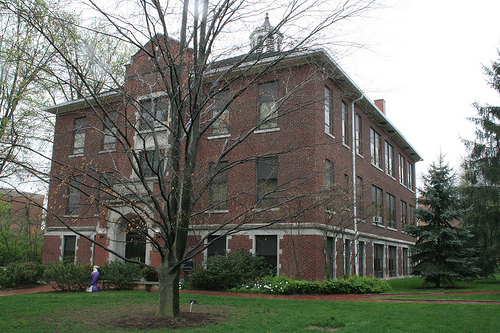Oldest building on campus to be demolished over Christmas break
October 21, 2010
Miller Hall, the oldest building on Ashland University’s campus, will be demolished over Christmas break to make way for a new academic building.
After debating the pros and cons of renovation versus demolition for two years, the Ashland University President’s Cabinet voted unanimously to have the building torn down, according to President Dr. Fred Finks.
“I think the facts speak for themselves and while many would like to preserve Miller for various reasons, in the end, it just doesn’t make sense,” Finks said.
There are no definite plans for the new building that will eventually replace Miller on the corner of the Avenue of the Eagles and the Academic Corridor, but Finks said a new arts and humanities building is one possibility. Rick Ewing, vice president of facilities management and planning, said a new social sciences building is another idea. Both disciplines currently have classes and faculty offices located in a variety of places on campus.
“[A new building would] really pull together some departments that are spread all over campus right now, so those faculty and students have a home,” Ewing said.
Although some were in favor of renovating Miller Hall to make it classroom-ready once again, it was determined that it would be too costly to renovate the inside of the building.
Built in 1923, Miller Hall was originally a library with administrative offices and a few classrooms. Since then, it has housed religion, history, business and science classes. However, the building has not been used since early 2007 due to the condition of the inside.
“Keeping Miller for only historical value didn’t make sense,” Finks said. “The building would have to be gutted completely inside, an elevator would have to be added to the building and renovation costs are staggering when compared to new construction.”
Ewing agreed.
“From the outside, I think Miller is a fine historical building,” he said. “I really appreciate the architecture of its form.”
Renovating the inside of Miller Hall, however, would have cost an estimated $6 million, he said. That estimate is from 2003, though, and could be higher today.
The estimate only covered enough renovations to make the building operational, Ewing added. Preparing Miller to meet current university needs – such as updating classrooms and adding on to the building – could cost even more.
“It’s always a gamble,” Ewing said. “To put renovation money into a facility that almost meets the needs versus putting money into something that exactly meets our needs… [Demolishing Miller] is a more cost efficient use of university dollars.”
Just making the building operational would require replacing the electrical system and the heating system – which currently includes the only steam boiler on campus, according to Ewing.
“The risk is going up exponentially every year we try to use [the boiler],” he said.
Last year, Facilities Management and Planning spent $2,000 to repair the boiler after it broke down, but the fix was only temporary, Ewing said.
Problems like the aging steam boiler are the main reason Miller Hall will be demolished despite its historical value, according to Finks.
“I believe in preservation whenever practical and possible,” he said.
The water system, roof and foundation would also need repairs.
The carpet in the basement had to be torn out last year due to flooding during heavy rainstorms, according to Ewing.
Miller Hall is scheduled to be torn down in December shortly after classes end for the semester.
According to Ewing, construction of the elevator in Founders Hall should be completed around that time, allowing the crew to move from Founders straight to Miller.


